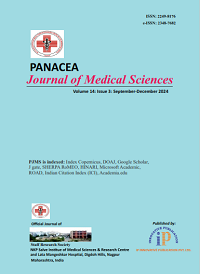Comparative study of clinical profile, Insulin and C-peptide levels in lean and obese Indian type 2 diabetic patients
DOI:
https://doi.org/10.18231/pjms.v.15.i.1.137-142Keywords:
C-peptide, Type 2 diabetes mellitus, Lean, ObeseAbstract
Background: We proposed hypothesis that obese and lean Indian type 2 diabetes mellitus patients would have diverse insulin secretory function and clinical representation. We conducted a study to compare serum Insulin, C-peptide levels, and clinical profile in lean and obese type 2 diabetes patients. Materials and Methods: Two hundred patients (100 underweight and 100 obese) were selected. Underweight (lean) was defined as BMI <18.5 kg/m2 and obese as BMI ≥ 25 kg/m2 according to world health organization (WHO) Asia Pacific criteria. The demographic characteristics, clinical profile, biochemical profile and complications were compared between lean and obese diabetic patients. Results: In lean compared to obese, there was higher prevalence of males (69% vs 42%), low socioeconomic status (78% vs 41%), higher rate of alcohol abuse (12% vs 5%) and cigarette smoking (32% vs 24%), more prevalent use of insulin (36% vs 24%), lower blood pressure, higher prevalence of peripheral neuropathy (46% vs 28%), higher retinopathy prevalence (33% vs 24%), lower coronary artery disease prevalence (9% vs 12%), lower TG level (190.86 ± 37.44 vs 241.7 ± 84.63, p-value < 0.0001), lower insulin level (6.404 ± 2.24 vs 23.82 ±2.04, p-value < 0.0001), lower C-peptide level (2.14 ±0.35 vs 2.48 ± 0.29, p-value < 0.0001) and higher HbA1c (9.818 ±1.95 vs 9.053 ±1.99, p-value 0.0066). Conclusion: In lean diabetic patient, non-traditional factors, acquired factors, and genetic predisposition may cause development of smaller beta cell mass and hence predominant insulin deficiency. We must have overcome the insulin resistance and cardiovascular risk factors in obese counterparts
Downloads
Published
2025-03-12
Issue
Section
Articles
How to Cite
Comparative study of clinical profile, Insulin and C-peptide levels in lean and obese Indian type 2 diabetic patients. (2025). Panacea Journal of Medical Sciences, 15(1), 137-142. https://doi.org/10.18231/pjms.v.15.i.1.137-142





